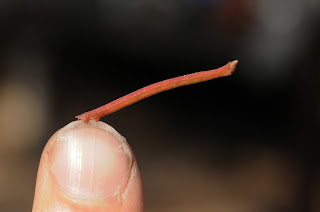The morning started strong with a Red Wattlebird and only our second Australian Reed-warbler of the season.
The Reed-warbler was aged as a 2 (in its second year of life) due to the condition of the feathers especially the tail, and the colour of the bird.
The plumage overall was fairly heavily worn, especially the central tail feathers (rectrices). These central rectrices are the last vestiges of the bird's juvenile plumage which was attained when it left the nest during the breeding season last year. At the end of that breeding season the bird underwent a partial post-juvenile moult, excluding the central rectrices. It has gone for most of a year in this plumage so looks well worn, however it has had the central rectrices for over a year and they are noticeably more worn.
Because is still has the juvenile feathers we can say it was born last year so is over 12 months old (age 2).
 |
| Australian Reed-warbler age 2. |
 |
| The central pair of tail feathers are heavily worn - retained from juvenile plumage most of which was replaced during the post-juvenile moult (as seen in the rest of the tail feathers). |
The duck net was productive as usual and it caught Pacific Black Duck, Grey Teal and a very uncommon bird for the Herdsman Lake project - Australian Ringneck.
Parrots are always a delight to extract from waterbird mist nets nets as the mesh is large enough for the bird's head to go through and you have to somehow hold onto its head to avoid getting bitten and simultaneously get the net off the angry parrot's head. It was worth the hassle; I don't have access to the data right now but we've only banded a handful of Ringnecks at Herdsman over the years.
On a final happy note the Willie Wagtail pulli that we banded last week are growing fast and looking very big! They were very active, standing up in the very crowded nest and begging for food from the parents.
The next morning they had fledged!
 |
| Willie Wagtail fledglings. Photo by Jennie Stock |
 |
| Fledgling being fed by one of its parents. Both parents are also banded! Photo by Jennie Stock |
Species - New (retrap)
Australian Reed-warbler - 1
Australian Ringneck - 1
Brown Honeyeater - 2
Grey Teal - 1
Pacific Black Duck - 2
Purple Swamphen - (1)
Red Wattlebird - 1
Rufous Whistler - (1)
Silvereye - 5 (5)
Singing Honeyeater - 1
Willie Wagtail - 2
Yellow-rumped Thornbill - (5)
Total - 16 (12) = 28































